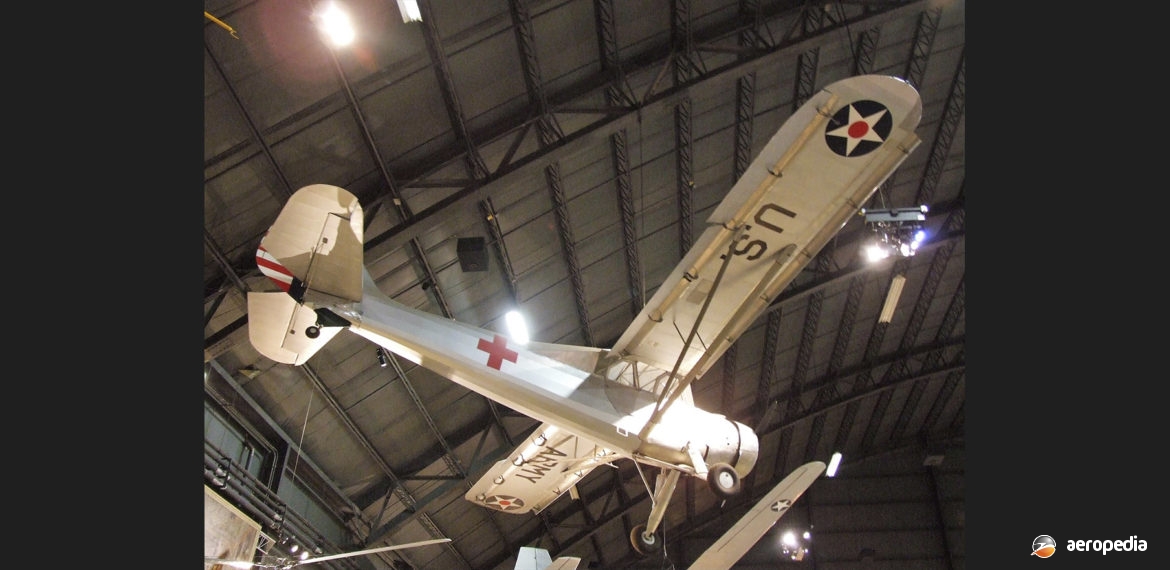Photograph:
Vultee L-1A Vigilant 41-19039 in the USAF Museum in Dayton, Ohio, USA (David C Eyre)
Country of origin:
United States of America
Description:
Two-seat liaison, observation, and ambulance monoplane
Power Plant:
One 220 kw (295 hp) Lycoming R-680-9 nine-cylinder air-cooled radial engine
Specifications:
- Wingspan: 15.5 m (50 ft 11 in)
- Length: 10.45 m (34 ft 3 in)
- Height: 3.10 m (10 ft 2 in)
- Wing area: 30.56 m² (329 sq ft)
- Max speed: 196 km/h (122 mph)
- Cruising speed: 145 km/h (90 mph)
- Initial rate of climb: 354 m/min (1,160 ft/min)
- Climb to 3,048 m (10,000 ft): 24.5 minutes
- Service ceiling: 3,901 m (12,800 ft)
- Range: 450 km (280 miles)
- Empty weight: 1,211 kg (2,670 lb)
- Loaded weight: 1,578 kg (3,480 lb)
History:
In 1940, in response to a US Army requirement for a two-seat unarmed light observation aircraft, Stinson produced the Model 74. Three examples were produced as the YO-49 and evaluated against the Bellanca YO-50 and the Ryan YO-51. Orders were subsequently placed for 142 aircraft known as the 0-49 and these became known as the Vultee O-49 Vigilant, as by this time Stinson had become a division of Vultee Aircraft Inc.
Low-speed and high-lift performance were provided by the braced monoplane wing incorporating leading-edge and trailing-edge high-lift devices. Power was provided by a Lycoming radial engine. A further contract was placed for 182 examples known as the 0-49A, these having a slightly longer fuselage (33 cm – 13 in) and some refinements and changes in the equipment installed. In 1942 the 0-49 and 0-49A models were redesignated the L-1 and L-1A, 100 being allocated to the RAF under the Lend Lease agreement between the UK and the US as the Vigilant Mk I and Mk II. Conversion for other roles resulted in the 0-49B (later L-1B) ambulance, L-1C also an ambulance, L-1D for pilot training and for glider pick-ups, L-1E amphibious floatplane, and the L-1F, a conversion of the L-1A to seaplane configuration. However, by this time the design of the Vigilant was overtaken by smaller, lighter and less costly aircraft and no more examples were built. After the war a number were converted for civil use.
A number were allocated to the RAAF and in this regard it was issued the serial series A64-. However, it would appear that none of the aircraft operated in Australian service had the RAAF serial painted on the aircraft. A few were operated in the south Pacific with USAAC serials, although they did have RAAF blue and white roundels applied and may have had a large red-cross painted on the fuselage to denote their ambulance duties. Examples are known to have operated on loan from the USAAC during the evacuation of Australian troops from Myola II airstrip in New Guinea by personnel of No 33 Squadron, RAAF. Three examples, all L-1C models, are known to have been attached to this Australian unit on 10 November 1942. They were flown and maintained by RAAF personnel under the Directorate of Air Transport in the Maple (Port Moresby) area and were only used for ambulance work.
The aircraft and their fates were: 41-18958 arrived on board the SS Egbert Benson on 12 August 1942 and was assembled at Fishermens Bend, VIC. It was operated by No 33 Squadron from 13 November 1942 but crashed at Chestnut Bay south-east of Port Moresby, PNG. This machine was salvaged by No 15 RSU in December 1942.
41-18959 arrived in Melbourne, VIC and was assembled at Fishermens Bend in August 1942. It was operated from 13 November 1942 by No 33 Squadron. It crashed at Myola Lake on the Kokoda Track in the district of Papua on 24 November 1942 after hitting a boggy patch and the undercarriage collapsing. It in due course was repaired in situ by No 15 RSU and flown to Berry Strip on 26 January 1943. Its subsequent history is not known.
41-19050 also arrived in Melbourne on board the SS Egbert Benson and was also assembled at Fishermens Bend. It took up duties with No 33 Squadron on 10 November 1942. As part of the campaign it made 12 return trips between Myola Lake and the Berry Strip before it crashed in the Myola Lake area whilst evacuating personnel.
One example (40-0283) was located in storage in Vancouver, Canada and imported to Auckland, New Zealand in 2003, where work commenced to restore it to airworthiness. However, in about 2009, it was exported to the United Kingdom for further restoration work.

